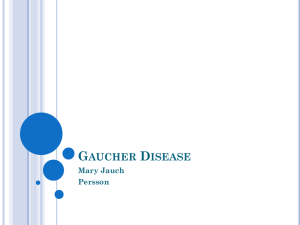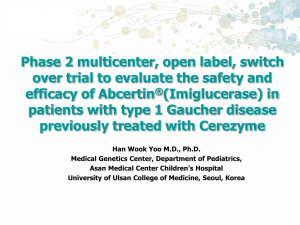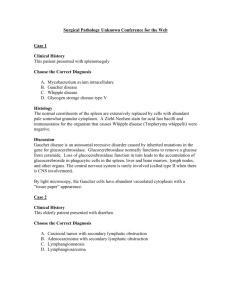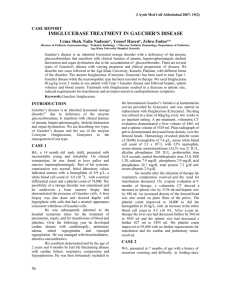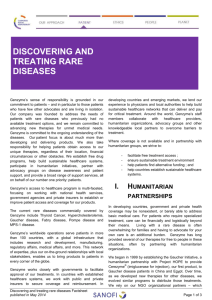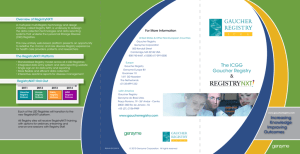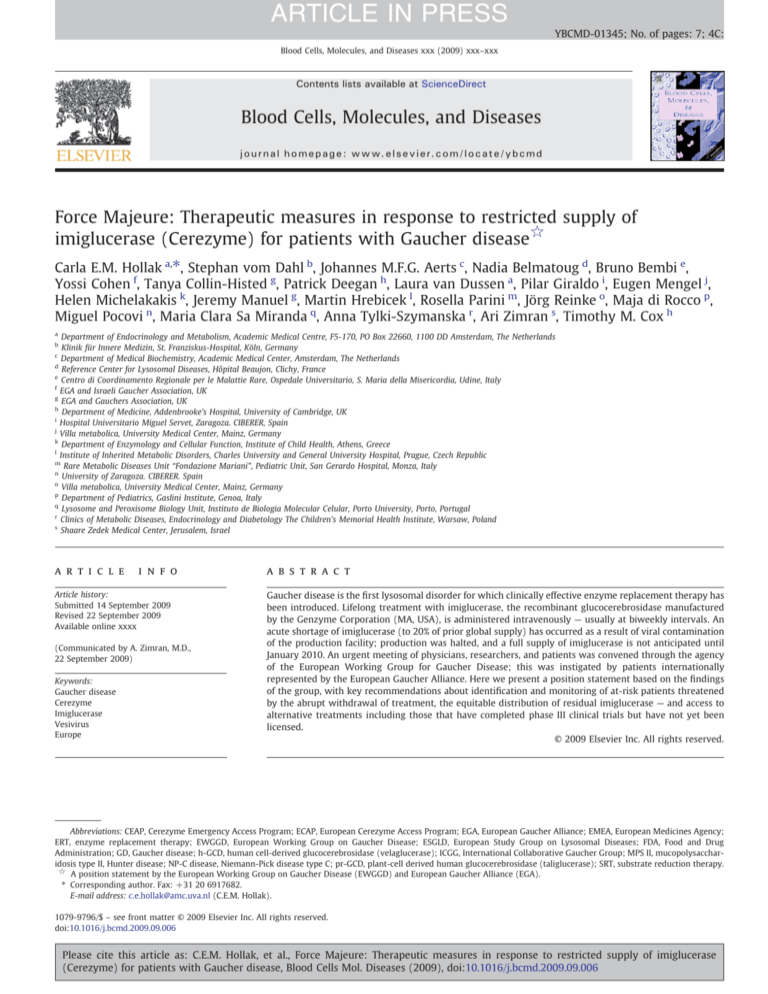
ARTICLE IN PRESS
YBCMD-01345; No. of pages: 7; 4C:
Blood Cells, Molecules, and Diseases xxx (2009) xxx–xxx
Contents lists available at ScienceDirect
Blood Cells, Molecules, and Diseases
j o u r n a l h o m e p a g e : w w w. e l s e v i e r. c o m / l o c a t e / y b c m d
Force Majeure: Therapeutic measures in response to restricted supply of
imiglucerase (Cerezyme) for patients with Gaucher disease☆
Carla E.M. Hollak a,⁎, Stephan vom Dahl b, Johannes M.F.G. Aerts c, Nadia Belmatoug d, Bruno Bembi e,
Yossi Cohen f, Tanya Collin-Histed g, Patrick Deegan h, Laura van Dussen a, Pilar Giraldo i, Eugen Mengel j,
Helen Michelakakis k, Jeremy Manuel g, Martin Hrebicek l, Rosella Parini m, Jörg Reinke o, Maja di Rocco p,
Miguel Pocovi n, Maria Clara Sa Miranda q, Anna Tylki-Szymanska r, Ari Zimran s, Timothy M. Cox h
a
Department of Endocrinology and Metabolism, Academic Medical Centre, F5-170, PO Box 22660, 1100 DD Amsterdam, The Netherlands
Klinik für Innere Medizin, St. Franziskus-Hospital, Köln, Germany
c
Department of Medical Biochemistry, Academic Medical Center, Amsterdam, The Netherlands
d
Reference Center for Lysosomal Diseases, Hôpital Beaujon, Clichy, France
e
Centro di Coordinamento Regionale per le Malattie Rare, Ospedale Universitario, S. Maria della Misericordia, Udine, Italy
f
EGA and Israeli Gaucher Association, UK
g
EGA and Gauchers Association, UK
h
Department of Medicine, Addenbrooke's Hospital, University of Cambridge, UK
i
Hospital Universitario Miguel Servet, Zaragoza. CIBERER, Spain
j
Villa metabolica, University Medical Center, Mainz, Germany
k
Department of Enzymology and Cellular Function, Institute of Child Health, Athens, Greece
l
Institute of Inherited Metabolic Disorders, Charles University and General University Hospital, Prague, Czech Republic
m
Rare Metabolic Diseases Unit “Fondazione Mariani”, Pediatric Unit, San Gerardo Hospital, Monza, Italy
n
University of Zaragoza. CIBERER. Spain
o
Villa metabolica, University Medical Center, Mainz, Germany
p
Department of Pediatrics, Gaslini Institute, Genoa, Italy
q
Lysosome and Peroxisome Biology Unit, Instituto de Biologia Molecular Celular, Porto University, Porto, Portugal
r
Clinics of Metabolic Diseases, Endocrinology and Diabetology The Children's Memorial Health Institute, Warsaw, Poland
s
Shaare Zedek Medical Center, Jerusalem, Israel
b
a r t i c l e
i n f o
Article history:
Submitted 14 September 2009
Revised 22 September 2009
Available online xxxx
(Communicated by A. Zimran, M.D.,
22 September 2009)
Keywords:
Gaucher disease
Cerezyme
Imiglucerase
Vesivirus
Europe
a b s t r a c t
Gaucher disease is the first lysosomal disorder for which clinically effective enzyme replacement therapy has
been introduced. Lifelong treatment with imiglucerase, the recombinant glucocerebrosidase manufactured
by the Genzyme Corporation (MA, USA), is administered intravenously — usually at biweekly intervals. An
acute shortage of imiglucerase (to 20% of prior global supply) has occurred as a result of viral contamination
of the production facility; production was halted, and a full supply of imiglucerase is not anticipated until
January 2010. An urgent meeting of physicians, researchers, and patients was convened through the agency
of the European Working Group for Gaucher Disease; this was instigated by patients internationally
represented by the European Gaucher Alliance. Here we present a position statement based on the findings
of the group, with key recommendations about identification and monitoring of at-risk patients threatened
by the abrupt withdrawal of treatment, the equitable distribution of residual imiglucerase — and access to
alternative treatments including those that have completed phase III clinical trials but have not yet been
licensed.
© 2009 Elsevier Inc. All rights reserved.
Abbreviations: CEAP, Cerezyme Emergency Access Program; ECAP, European Cerezyme Access Program; EGA, European Gaucher Alliance; EMEA, European Medicines Agency;
ERT, enzyme replacement therapy; EWGGD, European Working Group on Gaucher Disease; ESGLD, European Study Group on Lysosomal Diseases; FDA, Food and Drug
Administration; GD, Gaucher disease; h-GCD, human cell-derived glucocerebrosidase (velaglucerase); ICGG, International Collaborative Gaucher Group; MPS II, mucopolysaccharidosis type II, Hunter disease; NP-C disease, Niemann-Pick disease type C; pr-GCD, plant-cell derived human glucocerebrosidase (taliglucerase); SRT, substrate reduction therapy.
☆ A position statement by the European Working Group on Gaucher Disease (EWGGD) and European Gaucher Alliance (EGA).
⁎ Corresponding author. Fax: +31 20 6917682.
E-mail address: c.e.hollak@amc.uva.nl (C.E.M. Hollak).
1079-9796/$ – see front matter © 2009 Elsevier Inc. All rights reserved.
doi:10.1016/j.bcmd.2009.09.006
Please cite this article as: C.E.M. Hollak, et al., Force Majeure: Therapeutic measures in response to restricted supply of imiglucerase
(Cerezyme) for patients with Gaucher disease, Blood Cells Mol. Diseases (2009), doi:10.1016/j.bcmd.2009.09.006
ARTICLE IN PRESS
2
C.E.M. Hollak et al. / Blood Cells, Molecules, and Diseases xxx (2009) xxx–xxx
Introduction
Gaucher disease is one of the most frequent lysosomal storage
disorders in man. The disorder is caused by deficient activity of the
enzyme glucocerebrosidase (EC 321.45) [1,2], for which therapeutic
augmentation has proved to be highly effective. Gaucher disease is
clinically heterogeneous [3,4]. Often classified operationally into three
principal subtypes, the condition mainly affects the macrophage
system [5]. Visceromegaly and cytopenias as well as disabling bone
disease characterize type I disease. In contrast, manifestations in the
central nervous system define the neuronopathic forms of Gaucher
disease: type II disease, the acute and rapidly fatal form and type III
disease with a more attenuated neurological course [5].
Treatment with enzyme replacement therapy (ERT) was initially
developed using placentas as a resource and later using recombinant
technology [6–8]. This enzyme, imiglucerase, manufactured by Genzyme Corp, MA, USA, has become available in 1994 and currently more
than 1700 patients are being treated in Europe, parts of the Middle East
and North Africa. ERT requires an apparent lifelong treatment with
regular infusions. This therapy has shown to be extremely beneficial,
resulting in normalization of blood counts, reductions in spleen and
liver sizes, and improvement in bone symptoms [6–8]. So far ERT with
imiglucerase is the only registered enzyme. Two new enzyme preparations are at the final stages of development programs: velaglucerase
(h-GCB, Shire Human genetic Therapies, MA, USA) and taliglucerase
(pr-GCD, Protalix Biotherapeutics, Carmiel, Israel [9,10]). Substrate
reduction therapy (miglustat, Actelion therapeutics) is an oral treatment registered for Gaucher disease and indicated for mild to moderately affected adult patients for whom enzyme replacement therapy
is not suitable (EMEA) or not a therapeutic option (FDA) [11].
In June 2009, Genzyme identified a virus (vesivirus 2117) in one of
six bioreactors at the Allston manufacturing facility. The consequence
of this infection is that it impairs the viability of the non-human
Chinese Hamster Ovary (CHO) cells used to produce imiglucerase.
Genzyme reported that this virus is not known to cause disease in
humans. To clear the infection and restore full production rapidly,
Genzyme temporarily suspended the manufacture of imiglucerase — a
cessation that has caused a severe shortage of imiglucerase worldwide. At the end of June, the EMEA informed physicians in Europe of a
temporary shortage of imiglucerase, which was expected to last for
only a few weeks and with a reduction of supply to approximately 60%
of normal [12]. This estimate was based on the assumption that most
imiglucerase hypothecated to “work-in-process” (WIP) at the time of
that their plant was shutdown would become available for distribution. However, by early August, it became clear that 80% of this WIP
material would not to be released for further processing. Two lots
were eventually found to be safe for further use, resulting in a
worldwide availability of only 20% of the original amount of enzyme
until the end of the year.
Given this force majeure, only a minority of patients with Gaucher
disease can continue to receive treatment. The clinical implications of
a temporary interruption of treatment are not easy to predict. Gaucher
disease is heterogeneous; some patients have rapidly progressive
disease, especially in childhood, while others may remain stable
without treatment for decades. The consequences of treatment interruptions have only been documented in small groups of patients
[13–18]. In summary, some of these patients remained stable up to
47 months, but progression of the disease at variable rates has also
been reported. In many adult patients, interruption of therapy did not
cause immediate reversal of the achieved therapeutic effects (i.e.,
within weeks). Perhaps the most important overall conclusion is that
clinical deterioration may or may not occur when enzyme therapy is
interrupted but on the basis of current knowledge, which patient will
suffer a deterioration, if any, and to what extent, cannot be predicted.
In the United States, a Cerezyme Stakeholders Working Group
consisting of physicians, patients, and Genzyme representatives was
Table 1
Revised recommendations for Cerezyme (EMEA questions and answers document [20]
issued on August 14, 2009).
For Cerezyme, priority is given to infants, children and adolescents, and adults
with severe, life-threatening disease progression:
A. Infants, children, and adolescents should receive Cerezyme at a reduced dose or
at a reduced infusion frequency. However, no patient should be treated at a dose
lower than 15 U/kg body weight every 2 weeks, or alternative treatment should
be considered.
B. Adult patients with severe, life-threatening disease progression should receive
Cerezyme at a reduced dose or at a reduced infusion frequency. However, no
patient should be treated at a dose lower than 15 U/kg every 4 weeks, or
alternative treatment should be considered.
C. In adult patients without severe, life-threatening disease progression, alternative
treatment such as miglustat should be considered or treatment should be
interrupted.
D. Adults who demonstrate progression to severe, life-threatening disease should
re-initiate treatment with Cerezyme.
installed in response to this emergency. The group set out guidelines
for the protection of the most vulnerable patients [19]. In addition, it
should be noted that in early July, the FDA has contacted both Shire
and Protalix about the possibility of initiating a treatment protocol for
use of their phase III drugs at the time of imiglucerase shortage, and
accordingly, two new protocols have been approved (NCT00954460
and NCT00962260, respectively).
To protect the interests of Gaucher patients most at risk from
complications, in Europe, the EMEA released guidelines at the end of
June and revised these by mid-August. These guidelines are shown in
Table 1 [20]. Although the distribution of vulnerable patients is not
equal among the different European and affiliated countries, Genzyme
initially had to decide to allocate 20% of previously ordered enzyme to
each of these countries. The European and affiliated countries are
summarized in Table 2. Following the EMEA guidance and management by Genzyme, concerns arose within the Gaucher community
as to the equity of distribution, identification of patients at risk and
their monitoring — as well as the potential access to alternative and
emerging treatments. To address these concerns, a professional
meeting of stakeholders in Europe was organized rapidly, the results
of which are reported here.
Methods
Under the initiative of the European Gaucher Alliance (EGA), representing the interests of patients with Gaucher disease in Europe and
several affiliated nations, including Israel, expert physicians, patient
representatives, and laboratory experts met under the auspices of the
European Working Group on Gaucher Disease (EWGGD, a daughter of
the European Study Group on Lysosomal Diseases (ESGLD)). Pharmaceutical companies (Genzyme, Protalix, Shire, and Actelion) were
Table 2
Clusters of countries that comprise the European area, North Africa, and the Middle
East.
Included Countries
Nordic–Benelux:
• Benelux: Netherlands, Belgium, Luxembourg
• Nordics: Sweden, Norway, Finland, Denmark, Iceland
UK–Ireland
France: includes North Africa (Algeria, Morocco, Tunisia)
Central Europe:
• Germany, Switzerland
• North Central Europe: Poland, Estonia, Lithuania, Latvia
• South Central Europe: Austria, Hungary, Czech Republic, Croatia, Slovakia,
Slovenia
• Other Eastern European countries are included in Eurasian region
South Europe: Italy, Spain, Portugal, Greece, Israel, Turkey, and Middle East
Please cite this article as: C.E.M. Hollak, et al., Force Majeure: Therapeutic measures in response to restricted supply of imiglucerase
(Cerezyme) for patients with Gaucher disease, Blood Cells Mol. Diseases (2009), doi:10.1016/j.bcmd.2009.09.006
ARTICLE IN PRESS
C.E.M. Hollak et al. / Blood Cells, Molecules, and Diseases xxx (2009) xxx–xxx
invited during a separate session to present their view on the crisis.
The meeting was convened independently at Bad Honnef, Germany, on
September 10, 2009, prior to the meeting of the ESGLD and supported
in part by the ASIM (Arbeitsgemeinschaft für angeborene Stoffwechselstörungen in der Inneren Medizin), the German Working Group on
Inborn Metabolic Errors in Metabolism in Adults.
Key representatives of pharmaceutical companies were invited to
clarify their position in relation to the crisis of supply. The following
issues were considered in depth:
Imiglucerase supply: what is the current status of treatment continuation and interruption in Europe an affiliated countries?
EMEA guidelines: how can the EMEA guidelines be translated into
clinical practice, including the definition of severe, life-threatening
disease progression in adults and what would be the lowest
acceptable dose for those at risk?
Harmonization: how can equitable distribution of imiglucerase for
all patients in this area be achieved?
Monitoring: how would patients be monitored on low-dose/
alternative treatments or during cessation?
Use of miglustat: what is the therapeutic position of miglustat in
this crisis?
Access to unlicensed treatments: since the companies Protalix and
Shire inform us about opportunities for expanded access use of
their enzymes (taliglucerase and velaglucerase, respectively)
before licensing, how can this be managed and by what means
can consolidated applications for patients with urgent need be
made?
Results and discussion
Imiglucerase supply
What is the current status of treatment continuation and
interruption?
According to recent data from the Gaucher Registry, Europe and
affiliated countries (see Table 2) represent more than 35% of all
patients treated with imiglucerase worldwide. All participants were
asked to collect and present data on the number of patients treated
3
with imiglucerase before the shortage and the composition of this
population with respect to number of children and type III patients.
Also the number of patients who were forced to reduce their dose
significantly or had to interrupt treatment was recorded. Table 3
summarizes the data from this inventory, which include the numbers
provided for each of the countries represented during the meeting.
According to data from the International Collaborative Group on
Gaucher Disease (ICGG), this table represents 85% of patients treated
in these regions. All participants were asked to clarify the emerging
therapeutic position in their country of domain.
In France, The Comité d'Evaluation du Traitement de la maladie de
Gaucher (CETG) has translated the current EMEA criteria into a French
recommendation. Monthly meetings of this committee are scheduled.
More than 100 physicians are involved, and an independent national
registry has been set up. Of the 240 patients previously on imiglucerase treatment, 163 interrupt treatment, while 73 patients reduce
their dose and 4 patients remain on the original dose. Use of miglustat
is proposed or discussed for 21 patients. There is no current need for
additional imiglucerase in France to support patients at high risk, but
it is felt that about 20 patients will be eligible for inclusion in an
expanded access program for alternative therapeutic enzymes close to
registration (involved companies Shire Human Genetic Therapies,
USA, and Protalix, Israel).
In Israel, It is estimated that approximately 250 patients are on
ERT and 50 patients are considered to be in the high-risk group.
These are children (age b 18 years), pregnant women and type III
patients ≥ 18 years (only 2 patients). The high-risk group receives
imiglucerase as before. Others enter a 3-month drug interruption
with complete blood count (CBC) done at baseline and at 3 months.
Patients unwilling to stop ERT or experiencing acute medical problems are offered a switch-over protocol to taliglucerase (pr-GCD). It is
emphasized that also for open-access protocols, the local institutional
review board (IRB) has to be consulted. There has been a request for
Shire's enzyme (velaglucerase).
In the Czech Republic, 31 Gaucher patients are known. Of those, 23
were treated with ERT including one type III patient. Five patients
were treated with miglustat. Presently, 2 children and the type III
patients are at unchanged dose. Three type I GD patients have
switched to miglustat, and in the remaining 17, the dose of the
enzyme was reduced to 15 mg/kg per month. Current stocks of
imiglucerase will allow treatment at the reduced dose for about
Table 3
Distribution of types and ages of Gaucher disease patients among European and affiliated countries and current status of imiglucerase supply based upon information by the local
physician or researcher.
Total number of
living Gaucher
disease patients
France
Israel
Czech Republic
Italy
Spain
Greece
Germany
Poland
Portugal
United Kingdom
The Netherlands
Hungary
Eastern European Countriese
530
N 800
31
unknown
324
99
300
25
Unknown
On ERT
240
250c
23
224c
170
51c
250c
54
80c
232
59
23
77
1732
On SRT
25
0
5
4
40
3
unknown
0
4
b20
4
unknown
unknown
Childrena
39
30
2
39
25
11
40
13
2
39
8
4
33
271
Type III
Drug interruption
or significant
dose reduction
Data provided
byb
10
2
1
18
10
6
10
17
0
unknown
4
unknown
240
200
17
71
140
unknown
200
20
80
200
46
19
44
1277
NB
AZ
MH
BB, MR
PG
HM
EM
ATS
MCSM
PD, TC
CH, LD
78
d
SFe
a
Type III patients are mainly children, but not all.
Initials of names are as indicated in author list.
Number of treated patients is an estimation.
d
This was kindly received by e-mail from Prof. L. Marodi.
e
These numbers refer to patients within the European Cerezyme Access Program (ECAP) who receive their therapy through charitable supply of imiglucerase by Genzyme. Data
were provided by Selena Freisens from Genzyme.
b
c
Please cite this article as: C.E.M. Hollak, et al., Force Majeure: Therapeutic measures in response to restricted supply of imiglucerase
(Cerezyme) for patients with Gaucher disease, Blood Cells Mol. Diseases (2009), doi:10.1016/j.bcmd.2009.09.006
ARTICLE IN PRESS
4
C.E.M. Hollak et al. / Blood Cells, Molecules, and Diseases xxx (2009) xxx–xxx
3 weeks, after that the treatment will be interrupted. There is a
centralized coordination for the distribution in the Czech Republic.
In Italy, there are a total of 224 imiglucerase-treated patients of
whom 39 are children. Eighteen patients have type III GD. In some
Italian regions, large stocks of enzyme are available for the next
months and local re-distribution is discussed. Treatment has been
interrupted in 70 patients, none of whom are children or have severe
life-threatening comorbidity. Notwithstanding, of these 70 patients,
some have active bone disease.
In Greece, there are 99 patients known to have Gaucher disease. Of
these, 82 are type I, 11 type II, and 6 are type III. Fifty-one patients
have been receiving ERT, but there is no exact information on how
many patients have interrupted treatment or had their therapy
reduced significantly. Nonetheless it is believed that none of the
children will have dose restrictions. Three patients currently receive
treatment with miglustat.
In Spain 170 patients are on treatment with imiglucerase and
40 receive miglustat. Twenty-five of the 170 patients are children, and
10 patients are type III patients. Current stocks of imiglucerase are
minimal. Rules have been formulated by a national task force for
guaranteeing access to imiglucerase for the most severely affected
patients, but 140 patients have had their dose reduced or have
interrupted therapy. Recommendations for monitoring have been
formulated; accordingly, check-ups every 2 months in the respective
local hospitals are planned.
In the United Kingdom and Ireland, 232 patients are treated with
enzyme replacement therapy. Among these, 39 are children. Patients
receiving treatment by home infusions have diminishing and variable
stocks. Currently, most adult type I patients are on dose reduction or
have stopped therapy. Given that the UK is a region where enzyme
dosages have historically tended to be conservative, about 20 adult
patients receive an unchanged dose or a dose reduced by about 50%.
Patients have been offered miglustat. There is a restricted need to
allocate additional drug to support high-risk patients at the moment.
Although for a number of patients, use of either velaglucerase or
taliglucerase is an option that will be vigorously pursued, access to
non-licensed drugs raises logistical problems, since many patients
receive treatment at home and the degree of supervision ethically
required for administering an unlicensed agent would preclude
delivery of the drug in the domicillary environment.
In Germany, there are about 250 patients on ERT, including 30 type
I children who are currently receiving imiglucerase reduced to 50% of
their original dose. Ten type III children continue on a 50%–100% dose
according to age and three type III adults have switched to low dose in
combination with miglustat. Some adult cases with complications
remain on ERT, but a further reduction or interruption is expected in
200 patients during the coming months. A substantial number of
these patients had recent bone complications and disease progression
following prior dose reductions.
In Poland, a total of 54 patients receive imiglucerase. A large
proportion of these patients (17 of the 54) are children with type III
disease. Because of extra stock, resulting from dose reductions and
savings, most patients can remain on treatment at a reduced dose.
Type III children can maintain their original dose. There is a
centralized coordination for the distribution in Poland.
In Portugal, there are 80 type I GD patients on therapy with
imiglucerase of 110 diagnosed patients. Four patients receive
miglustat. Very few patients have type II, and no patients have type
III disease. Two type I children need to be treated immediately and are
currently not receiving enzyme. Allocation of enzyme to Portugal is
needed, since there is no residual stock available. There is a committee
for the centralized coordinated distribution of imiglucerase.
In Netherlands, of 59 patients on imiglucerase treatment, 8 children
(4 type III) were maintained at a 50% reduced dose as well as 5 adults
identified to belong to the high-risk group. The remaining 46 patients
have either interrupted treatment or had a significant dose reduction.
Oral therapy with miglustat is initiated in 2–3 patients. It is felt that
for a number of patients, use of either velaglucerase or taliglucerase
can be an option.
Eastern European Countries. The Eastern European Cerezyme
Access Program is a charitable initiative by Genzyme, to supply free
imiglucerase to patients with GD in these countries. Most of these
countries lack financial resources to reimburse therapy, although
some governments can pay for a limited amount of patients. Here, 77
patients with generally more severe disease compared to patients in
the Western European countries, including 33 children, are receiving
imiglucerase therapy. The patients are particularly vulnerable because
of the relatively high proportion of severely affected individuals, the
high number of children, the shorter duration of therapy, and the
incapability to access alternative treatments. During discussions with
the supervising ECAP board, extra imiglucerase has become available
from postponed earlier shipments, which allows all children to be
treated at 50% of their initial dose and all adults at 15 U/kg every other
week until December.
In summary, the current inventory shows that most patients
who are expected to be at the immediate risk to experience complications from treatment interruption will remain on imiglucerase
treatment, albeit at a reduced dose. On the other hand, Table 3
clearly shows that out of N1700 patients on ERT, around 80% will
experience a substantial dose reduction or cessation of therapy. It
was felt during meeting that around 15%–20% of these patients
might become at risk for complications and that alternative treatments should be explored.
EMEA guidelines
How can the EMEA guidelines be translated into clinical practice,
including the definition of severe, life-threatening disease progression
in adults and what would be the lowest acceptable dose for those at
risk?
As indicated above, EMEA provided guidelines for the definition of
the most vulnerable patients (Table 2). These guidelines were
discussed. Although there was general agreement that priority should
be given to infants, children and adolescents, and adults with severe,
life-threatening disease progression, the definition of the latter group
of patients is insufficient for clinical practice. Also, the recommendations for dose reduction are not optimal; a dose of 15 U/kg per 2 weeks
for infants, children, and adolescents may be sufficient for the less
affected, but certainly not for the more severely affected patients.
Also, the proposed 15 U/kg every 4 weeks for adults makes no sense.
There is only evidence for some efficacy in the case of such dose
administered at high frequency, i.e., 1.15 U/kg three times a week [21].
To adopt this historic protocol in the current situation is unpractical
and this monthly dose at a 2- or 4-week interval is probably not
effective. It was thus proposed to maintain infants, children, and
adolescents at 50% of their dose and adults at high risk at a minimum
of 15 U/kg every 2 weeks, either covered by local supplies or through
an application for treatment from an emergency supply of imiglucerase pooled from diverse sources (see below).
In a plenary session, the group then discussed the criteria for being
at “high risk” for the development of complications from Gaucher
disease. These criteria are summarized in Table 4.
Harmonization
How can equitable distribution of imiglucerase for all patients in
this area be achieved?
There was agreement at the meeting that equity was not
guaranteed by an equal distribution of 20% of previously ordered
enzyme to each of the countries/country clusters. It was also
acknowledged that Genzyme could not require to direct a more
justifiable distribution. The inequity is based upon the following
Please cite this article as: C.E.M. Hollak, et al., Force Majeure: Therapeutic measures in response to restricted supply of imiglucerase
(Cerezyme) for patients with Gaucher disease, Blood Cells Mol. Diseases (2009), doi:10.1016/j.bcmd.2009.09.006
ARTICLE IN PRESS
C.E.M. Hollak et al. / Blood Cells, Molecules, and Diseases xxx (2009) xxx–xxx
Table 4
Criteria that identify patients at high risk for the development of progressive disease or
complications.
A. Infants, children, adolescents
B. Adult patients (either type I
or III) with:
– Exacerbation of disease while on dose
reduction/dose interruption
– Platelet count b 20.000/μl
– Thrombocytopenia and bleeding
– Symptomatic anemia
– Severe comorbidity requiring imiglucerase
treatment, such as:
1. Need for chemotherapy
2. Condition that puts a patient at risk for
bleeding, e.g., cirrhosis, major surgery,
that cannot be postponed for 3–6 months
3. Lung disease caused by Gaucher cell
infiltration
4. New acute bone event during last
12 months
C. Pregnant women with
symptomatic Gaucher
disease
differences between countries: (1) numbers of children, (2) numbers
of type III patients, (3) dosing — some countries prescribing higher
doses than others, for ostensibly equally affected patients.
It was agreed that re-allocation based upon medical emergency
rather than historic use should be installed to warrant access to
uninterrupted therapy for the patients who are considered most
vulnerable. For this purpose, an independent pool of imiglucerase
should be created, consisting of approximately 20% of the total
amount for Europe and affiliated countries. A group of physicians was
commissioned under the auspices of the EWGGD, to consider
applications for those patients. For logistical reasons, a prerequisite
to the granting of an application is that import of imiglucerase should
be feasible within 1 month. An application form can be downloaded at
www.amc.nl/cetp, www.ESGLD.org or www.gaucher.org.uk. To facilitate the smooth operation of this body and as far as possible ensure
consistent standards of evaluation, it was agreed to employ a similar
infrastructure to Genzyme's European Cerezyme Access Programme
(ECAP) for this purpose, but to keep the supervision and central
organization independent. Further details to this program can be
found at the abovementioned Web sites.
On meeting senior representatives of the Genzyme Corporation,
the group discussed how Genzyme could further assist European
patients and those whose interests were subtended by the EGA.
Genzyme indicated that logistical support could be organized as well
as re-allocation before distribution has taken place (Genzyme noted
that they are not able to re-allocate based on clinical needs, as this
information is not available to them). Existing stocks in several
countries, however, cannot be re-distributed by Genzyme. It was also
discussed whether the imiglucerase vials, reserved for the phase III
program of the new oral small molecule (GENZ-112638), could be
released for normal use during the shortage. In this trial, noninferiority will be investigated in a 2:1 randomized trial of GENZ112638 versus imiglucerase as control arm; the trial will include
patients who are mild to moderately affected and have stable disease.
Both the FDA and EMEA had expressed great concerns about
postponing this study — a view clearly shared by Genzyme. In view
of the urgency of the issue, an emergency pool to treat the most
severely affected patients was created as described above. It was
considered that this would expedite the further enrolment of patients
into the trial and obviate delay.
Monitoring
How would patients be monitored on low-dose/alternative
treatments or during cessation?
5
Recommendations for monitoring during imiglucerase reduction
or cessation of enzyme replacement therapy and during the recovery
period were made by the group. Although some physicians were
convinced that monitoring every month was not indicated in most
patients, others felt that the more frequent monitoring would help to
understand the implications of treatment interruptions and perhaps
to identify patients at risk for progression at an early stage. The
following guidelines were agreed:
• clinical examination and history at least every 3 months,
• complete blood count at least every 3 months, and
• plasma sample for biomarker analysis such as chitotriosidase.
For the assessment of chitotriosidase, it was recommended to
employ local laboratory facilities for early evaluations, using percentage increase from baseline as a possible indication of deterioration.
For an analysis of absolute values in the entire group, the stored
plasma sample can afterwards be assayed at a central facility to
correct for differences between laboratories.
Results of all follow-up studies need to be carefully recorded, and
all were encouraged to submit these data to the Gaucher Registry of
the International Collaborative Gaucher Group (ICGG) and/or national
registries.
Use of miglustat
What is the therapeutic position of miglustat in this crisis?
Miglustat (Zavesca) has been licensed for use in type I Gaucher
patients in the United States, the European Union, and other
countries; in the European Union, it is also licensed for the treatment
of Niemann-Pick type C disease patients. The indication in Gaucher
disease is granted to patients with mild and moderate forms of the
disease, for whom enzyme replacement therapy is unsuitable [11].
Theoretically, this definition would, after discontinuation of the drug
imiglucerase, be applicable for many patients in the European area
(see Table 3). It was pointed out by Actelion that the supply of
miglustat can fully match possible needs for those European patients
who are no longer able to receive enzyme therapy. Actelion also
indicated that no data from current or other studies could give
evidence for a role of miglustat in forms of the disease other than mild
and moderate. Recent data on long-term maintenance with miglustat
in patients who had been switched from previous enzyme therapy
have been reported from Spain in the ZAGAL study [22]. This and
other studies consider the impact of miglustat on bone manifestations
of Gaucher disease [23]. While there are currently no plans to have
expanded access in order to provide miglustat in countries where it is
not approved, Actelion will bear the costs of treatment in those
countries where miglustat is licensed, but currently not reimbursed.
This will be the case until reimbursement has been granted or the
shortage of imiglucerase has ended.
Access to unlicensed treatments
Since the companies Protalix and Shire inform us about opportunities for expanded access use of their enzymes (taliglucerase and
velaglucerase, respectively) before licensing, how can this be managed and by what means can consolidated applications for patients
with urgent need be made?
The company Protalix indicated that their product taliglucerase
alfa, a recombinant form of human glucocerebrosidase produced in
plants cells culture, is now available for hundreds of patients. It was
stated that in 2010 Protalix will have the capacity to supply drug for
more than 1000 patients and capacity for over 2500 patients by the
end of 2010. The fast large-scale availability of taliglucerase alfa
appears as a consequence of the unique production process of Protalix. Drug approval applications for taliglucerase alfa are in progress
in various countries.
Please cite this article as: C.E.M. Hollak, et al., Force Majeure: Therapeutic measures in response to restricted supply of imiglucerase
(Cerezyme) for patients with Gaucher disease, Blood Cells Mol. Diseases (2009), doi:10.1016/j.bcmd.2009.09.006
ARTICLE IN PRESS
6
C.E.M. Hollak et al. / Blood Cells, Molecules, and Diseases xxx (2009) xxx–xxx
For use as a compassionate use compound, the physicians in the
individual countries would be required to approach their local
authorities and to specifically approach Protalix with a request letter.
In Germany and the UK, where this compassionate product release
mechanism is about to be initiated, it is estimated that the time from
the request to local delivery of the enzyme for infusion would be
around 6 weeks based on the local regulatory timelines. Based on the
phase III clinical study, which have been recently concluded, the initial
registration application of the product has been submitted to the FDA.
Fast-track approval has been granted as well as Orphan drug designation by the FDA. Practically, the company has to be contacted for use
of the drug on a “compassionate use” or “named patient” basis, where
permission by the local authorities will be granted. The patient will
have to sign a consent form in order to receive the drug, which will be
provided for a minimum of 9 months at no costs until marketing
approval. It should be noted that at the present time, the treatment
could only be available for adult patients aged N18 years, yet,
pregnancy is not contraindicated.
The company Shire Human Genetic Therapies (HGT) estimates
that it can provide uninterrupted treatment of velaglucerase alfa, their
human-cell-derived glucocerebrosidase, for 300 to 600 type I Gaucher
patients worldwide in 2009. Shire HGT has accelerated its manufacturing timelines and expects to be able to add several hundred more
patients worldwide in 2010. The total number of patients who can be
treated is dependent on patient weight, as well as the administered
dose as recommended by the treating physician. Shire recently
announced positive results from all three of its phase III studies, the
submission of its New Drug Application to the US Food and Drug
Administration, and the availability of velaglucerase alfa in the US
through a treatment protocol. The company has requested an expedited review of its velaglucerase alfa Paediatric Investigational Plan
and Marketing Authorisation Application (MAA) from the European
Medicines Agency. To respond to the global supply shortage, Shire
HGT has initiated processes for pre-approval access in a number of
countries in the European Union and elsewhere. The company had a
very positive recent experience with pre-approval access programs
for Elaprase, their recombinant human-cell-derived idursulfase for
the treatment of MPS II. Shire HGT is committed to providing patients
started on velaglucerase alfa with uninterrupted treatment through
the periods of MAA review, pricing and reimbursement timelines, and
beyond. Requests for “compassionate use” or “named patient” use of
velaglucerase alfa should be directed to Shire HGT's local medical
directors. While this enzyme can be given to children, at the present
time, pregnancy is an exclusion criterion.
As to access to the new small molecule compound, GENZ-112638,
by the company Genzyme, the American authorities (FDA) have
reinforced the importance of completing the proposed phase III trials
and therefore will not approve the request for a compassionate use
program. The current studies, which compare the use of GENZ112638 with the conventional use of imiglucerase, will be extended.
Enrolment of the patients within this study will require the normal
approved process of a randomized clinical trial (RCT). There is
currently no early access program in place for this agent.
Conclusions
The force majeure leading to an acute lack of imiglucerase therapy
for the chronic treatment of Gaucher disease patients is unprecedented and has shocked the entire Gaucher community. The
possibility of such an event has hitherto not been imagined by
either physicians or patients — but nonetheless, the episode vividly
illustrates the vulnerability of sophisticated biotechnology as well as
the need for safety measures (stocks of products and/or effective
alternatives). In the early aftermath of this crisis, the FDA and EMEA
have played very different roles. For similar situations in the future, it
is strongly recommended that expert physicians and patient orga-
nizations are consulted before guidelines are issued. During the
EWGGD/EGA meeting, it was acknowledged that sufficient imiglucerase was available to maintain treatment, albeit at lower dose, for
most infants, children, adolescents, and critically affected patients.
Less severely affected patients with stable disease would probably
not experience important clinical consequences during a treatment
interruption of 3–6 months. Miglustat could be an option in those
patients as well, depending on local prescription policies. For
patients in need of enzyme treatment as defined in this article, the
willingness of Protalix and Shire to make their products available is
encouraging. Both enzymes are close to registration. Finally, this
unfortunate event has emphasized the role for an independent
working group for Gaucher disease, the EWGGD, as well as the EGA
in providing advice as well as consenting to a compassionate reallocation of imiglucerase. This EWGGD/EGA consortium will also
further consider how the disaster can best be used as an opportunity
to study the course of Gaucher disease after unplanned dose
reduction or interruption.
Disclosures
Carla E.M. Hollak received reimbursement of expenses and small
honoraria for lectures from Genzyme Corporation, Shire HGT, and
Actelion. All honoraria are donated to the Gaucher Stichting, a national
foundation that supports research in the field of lysosomal storage
disorders.
Stephan vom Dahl received research grants, reimbursement of
expenses, consulting fees, and honoraria for lectures from Genzyme
Corporation, Actelion Pharmaceuticals, and Shire Human Genetic
Therapies.
Johannes M.F.G. Aerts received reimbursement of expenses and
small honoraria for lectures and teaching courses from Genzyme
Corporation, Shire HGT, and Actelion. All honoraria are donated to the
Gaucher Stichting, a national foundation that supports research in the
field of lysosomal storage disorders. Nadia Belmatoug received grants
for research form Genzyme, Shire HGT, and Actelion. These grants
were provided to the association APRIMI.
Bruno Bembi received reimbursement of expenses and small
honoraria for lectures on lysosomal disorders treatment, including
Gaucher disease, from Genzyme Corporation and Actelion.
Yossi Cohen, Tanja Collin-Histed, and Jeremy Manuel are members
of the EGA. The EGA have received unrestricted grants from the
Genzyme Corporation, Shire Human Genetic Therapies, and Protalix
Biotherapeutics. It is EGA policy not to accept grants of more that 30%
of its annual budget from any one pharmaceutical company.
Patrick Deegan received speaking fees from Genzyme, Shire HGT,
and Actelion.
Laura van Dussen has nothing to disclose.
Pilar Giraldo has received small fees from Shire and Actelion for
lectures and sponsored events. All honoraria are donated to the
Spanish National Gaucher Foundation, which supports research in the
field of lysosomal storage disorders.
Eugen Mengel has received speakers fees from Genzyme, Actelion,
and Shire as well as research grants from Genzyme and Actelion.
Helen Michelakakis has received honoraria from Actelion,
Genzyme, and Biomarin.
Martin Hrebicek has nothing to disclose.
Rosella Parini has nothing to disclose.
Jörg Reinke has received speakers fees from Actelion and Shire.
Maja di Rocco received speaker's fees from Genzyme and Actelion.
Miguel Pocovi has received small fees from Shire and Actelion for
lectures and sponsored events. All honoraria are donated to the
Spanish National Gaucher Foundation, which supports research in the
field of lysosomal storage disorders.
Maria Clara Sa Miranda received research grants from Genzyme,
Shire,Biomarin (given to the Instituto de Biologia Molecular e Celular).
Please cite this article as: C.E.M. Hollak, et al., Force Majeure: Therapeutic measures in response to restricted supply of imiglucerase
(Cerezyme) for patients with Gaucher disease, Blood Cells Mol. Diseases (2009), doi:10.1016/j.bcmd.2009.09.006
ARTICLE IN PRESS
C.E.M. Hollak et al. / Blood Cells, Molecules, and Diseases xxx (2009) xxx–xxx
Anna Tylki-Szymanska received honoraria from Genzyme for
lectures.
Ari Zimran receives consulting fees from Shire HGT and from Protalix
Biotherapeutics; he has stock options with Protalix and receives research
reimbursement of expenses and occasional honoraria for lectures from
Genzyme Corporation. Genzyme also provides a grant to the Gaucher
Clinic to support its participation in the Gaucher Registry (ICGG).
Timothy Cox has received occasional lecturing and conference fees
from Actelion, Genzyme, and Shire HGT; specific remunerations for
professional advice from Actelion, Genzyme, and Shire HGT; and
unrestricted grants from Genzyme and Shire HGT for research not
related to Gaucher disease.
Acknowledgments
We appreciate the generous support by ASIM (Arbeitsgemeinschaft
für angeborene Stoffwechselstörungen in der Inneren Medizin) to
conduct the meeting.
The input from physicians and patients in Europe and affiliated
countries who were not present at the meeting is highly valued. We
are grateful for the data provided by Genzyme concerning the Eastern
European countries. We acknowledge the help of P.J.T. Hollak, PH
Translations, for editorial support.
References
[1] R.O. Brady, J.N. Kanfer, D. Shapiro, Metabolism of glucocerebrosides, II: evidence of
an enzymatic deficiency in Gaucher's disease, Biochem. Biophys. Res. Commun. 18
(1965) 221–225.
[2] A.D. Patrick, Short communications: a deficiency of glucocerebrosidase in
Gaucher's disease, Biochem. J. (1955) 97.
[3] E. Sidransky, Gaucher disease: complexity in a “simple” disorder, Mol. Genet.
Metab. 83 (2004) 6–15.
[4] T.M. Cox, J.P. Schofield, Gaucher's disease: clinical features and natural history,
Baillieres Clin. Haematol. 10 (1997) 657–689.
[5] E. Beutler, G.A. Grabowski, Gaucher disease, in: C.R. Scriver, A.L. Beaudet, W.S. Sly,
D. Valle (Eds.), The Metabolic and Molecular Bases of Inherited Disease, McGrawHill, New York, 2001, p. 3636.
[6] N.W. Barton, R.O. Brady, J.M. Dambrosia, A.M. Di Bisceglie, et al., Replacement
therapy for inherited enzyme deficiency — macrophage-targeted glucocerebrosidase for Gaucher's disease, N. Engl. J. Med. 324 (1991) 1464–1470.
7
[7] G.A. Grabowski, N.W. Barton, G. Pastores, J.M. Dambrosia, et al., Enzyme therapy in
type 1 Gaucher disease: comparative efficacy of mannose-terminated glucocerebrosidase from natural and recombinant sources, Ann. Intern. Med. 122 (1995)
33–39.
[8] A. Zimran, D. Elstein, E. Levy-Lahad, S. Zevin, et al., Replacement therapy
with imiglucerase for type 1 Gaucher's disease, Lancet 345 (8963) (1995)
1479–1480.
[9] A. Zimran, K. Loveday, C. Fratazzi, D. Elstein, A pharmacokinetic analysis of a novel
enzyme replacement therapy with gene-activated(R) human glucocerebrosidase
(GA-GCB) in patients with type 1 Gaucher disease, Blood Cells Mol. Dis. 39 (1)
(2007) 115–118.
[10] D. Aviezer, E. Brill-Almon, Y. Shaaltiel, S. Hashmueli, et al., A plant-derived
recombinant human glucocerebrosidase enzyme — a preclinical and phase I
investigation, PLoS ONE 4 (3) (2009) e4792.
[11] T.M. Cox, J.M. Aerts, G. Andria, M. Beck, et al., The role of the iminosugar Nbutyldeoxynojirimycin (miglustat) in the management of type I (non-neuronopathic) Gaucher disease: a position statement, J. Inherit. Metab. Dis. 26 (2003)
513–526.
[12] European Medicines Agency (EMEA). PRESS RELEASE. Supply shortages of
Cerezyme and Fabrazyme — priority access for patients most in need of treatment
recommended. 25-6-2009.
[13] D. Elstein, A. Abrahamov, I. Hadas-Halpern, A. Zimran, Withdrawal of enzyme
replacement therapy in Gaucher's disease, Br. J. Haematol. 110 (2000) 488–492.
[14] S. vom Dahl, L.W. Poll, D. Haussinger, Clinical monitoring after cessation of
enzyme replacement therapy in M, Gaucher. Br. J. Haematol. 113 (2001)
1084–1087.
[15] I.V. Schwartz, S. Karam, P. Ashton-Prolla, K. Michelin, et al., Effects of imilglucerase
withdrawal on an adult with Gaucher disease, Br. J. Haematol. 113 (2001) 1089.
[16] K.A. Grinzaid, E. Geller, S.L. Hanna, L.J. Elsas, Cessation of enzyme replacement
therapy in Gaucher disease, Genet. Med. 4 (2002) 427–433.
[17] J. Toth, M. Erdos, L. Marodi, Rebound hepatosplenomegaly in type 1 Gaucher
disease, Eur. J. Haematol. 70 (2003) 125–128.
[18] G. Drelichman, E. Ponce, N. Basack, et al., Clinical consequences of interrupting
enzyme replacement therapy in children with type 1 Gaucher disease, J. Pediatr.
151 (2007) 197–201.
[19] U.S. Cerezyme Stakeholders Working Group. Revised Guidance to the U.S. Gaucher
Community: Management of Cerezyme® (imiglucerase for injection) Supply. 108-2009.
[20] European Medicines Agency (EMEA). Questions and answers on the shortages of
Cerezyme and Fabrazyme. 14-8-2009.
[21] C.E.M. Hollak, J.M. Aerts, R. Goudsmit, S.S. Phoa, et al., Individualised low-dose
alglucerase therapy for type 1 Gaucher's disease, Lancet 345 (1995) 1474–1478.
[22] P. Giraldo, P. Alfonso, K. Atutxa, M.A. Fernández-Galán, et al., Real-world clinical
experience with long-term miglustat maintenance therapy in type 1 Gaucher
disease: the ZAGAL project, Haematologica (2009) (Jul 16 Electronic publication
ahead of print).
[23] G.M. Pastores, D. Elstein, M. Hrebícek, A. Zimran, Effect of miglustat on bone
disease in adults with type 1 Gaucher disease: a pooled analysis of three
multinational, open-label studies, Clin. Ther. 29 (2007) 1645–1654.
Please cite this article as: C.E.M. Hollak, et al., Force Majeure: Therapeutic measures in response to restricted supply of imiglucerase
(Cerezyme) for patients with Gaucher disease, Blood Cells Mol. Diseases (2009), doi:10.1016/j.bcmd.2009.09.006

